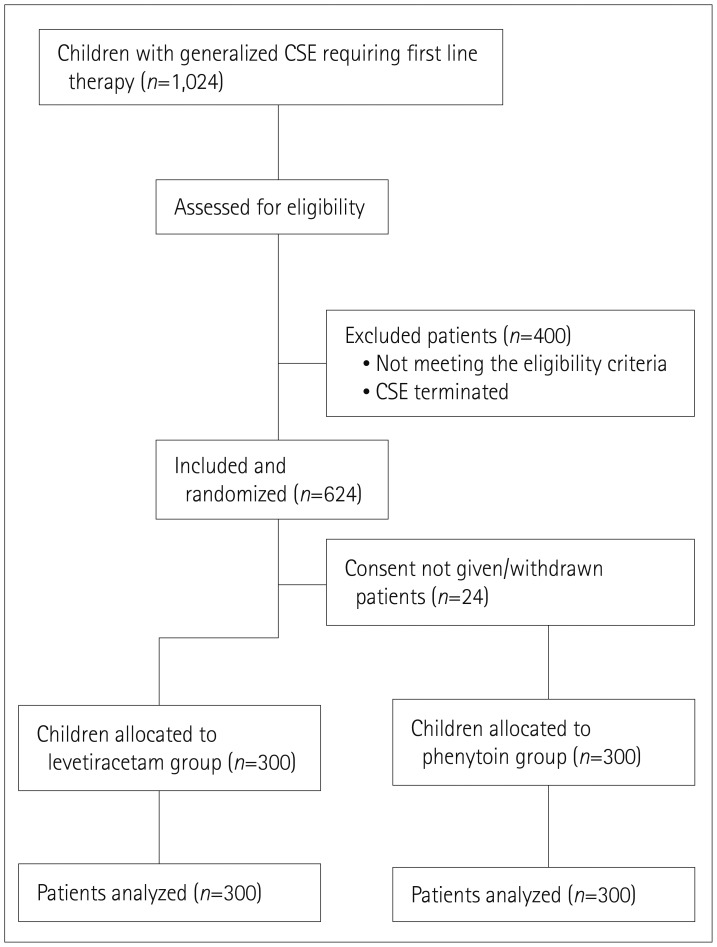J Clin Neurol.
2019 Oct;15(4):468-472. 10.3988/jcn.2019.15.4.468.
Clinical Efficacy and Safety of Injectable Levetiracetam Versus Phenytoin as Second-Line Therapy in the Management of Generalized Convulsive Status Epilepticus in Children: An Open-Label Randomized Controlled Trial
- Affiliations
-
- 1Department of Paediatric Neurology, The Children Hospital and Institute of Child Health Multan, Multan, Pakistan. drnuzhatrana@gmail.com
- 2Department of Paediatrics, The Children Hospital and Institute of Child Health Multan, Multan, Pakistan.
- 3Paediatric Intensive Care Unit, The Children Hospital and Institute of Child Health Multan, Multan, Pakistan.
- 4Medical Affairs Department, Hilton Pharma Pvt Ltd, Karachi, Pakistan.
- KMID: 2467755
- DOI: http://doi.org/10.3988/jcn.2019.15.4.468
Abstract
- BACKGROUND AND PURPOSE
There is sparsity of quality evidence for the use of drugs after first-line benzodiazepines in convulsive status epilepticus in children. The aim of the study was to compare the clinical efficacy and safety of intravenous levetiracetam versus intravenous phenytoin as second-line drugs in the management of generalized convulsive status epilepticus in children.
METHODS
This open-label randomized controlled trial was conducted in the Emergency Department of The Children's Hospital and The Institute of Child Health, Multan, Pakistan over a period of 4 years and 6 months from January 2014 to June 2018. This study included 600 children with generalized convulsive status epilepticus: 300 in the 40 mg/kg levetiracetam group, and 300 in the 20 mg/kg phenytoin group. Cessation of a clinical seizure (seizure cessation rate) within 30 minutes after the end of drug administration was the primary outcome in this study, and the presence or absence of adverse effects was noted as the secondary outcome. Data were analyzed using SPSS (version 20.0).
RESULTS
The children in the levetiracetam and phenytoin were aged 3.5±0.2 and 3.4±0.2 years (mean±SD), respectively, their seizure durations before the start of treatment were 25.1±0.6 and 23.8±0.4 minutes, and their treatment efficacies were 278/300 (92.7%) and 259/300 (83.3%). Levetiracetam was significantly more effective than phenytoin (p=0.012), with no significant difference in safety. Adverse events were observed in eight children in the phenytoin group.
CONCLUSIONS
Levetiracetam is significantly more effective than phenytoin for the treatment of convulsive status epilepticus in children who have failed to respond to benzodiazepines.
MeSH Terms
Figure
Reference
-
1. Novorol CL, Chin RF, Scott RC. Outcome of convulsive status epilepticus: a review. Arch Dis Child. 2007; 92:948–951. PMID: 17954477.
Article2. Raspall-Chaure M, Chin RF, Neville BG, Scott RC. Outcome of paediatric convulsive status epilepticus: a systematic review. Lancet Neurol. 2006; 5:769–779. PMID: 16914405.
Article3. Advanced Life Support Group. APLS 6e manual updates [Internet]. Manchester: Advanced Life Support Group;2018. cited 2019 May 1. Available from: https://www.alsg.org/en/files/APLS/APLS_6e_Manual_updates.pdf.4. Appleton RE, Gill A. Adverse events associated with intravenous phenytoin in children: a prospective study. Seizure. 2003; 12:369–372. PMID: 12915082.
Article5. Gallop K. Review article: phenytoin use and efficacy in the ED. Emerg Med Australas. 2010; 22:108–118. PMID: 20534046.
Article6. Berning S, Boesebeck F, Van Baalen A, Kellinghaus C. Intravenous levetiracetam as treatment for status epilepticus. J Neurol. 2009; 256:1634–1642. PMID: 19458986.
Article7. McTague A, Kneen R, Kumar R, Spinty S, Appleton R. Intravenous levetiracetam in acute repetitive seizures and status epilepticus in children: experience from a children's hospital. Seizure. 2012; 21:529–534. PMID: 22722010.
Article8. Zelano J, Kumlien E. Levetiracetam as alternative stage two antiepileptic drug in status epilepticus: a systematic review. Seizure. 2012; 21:233–236. PMID: 22321334.
Article9. Wright C, Downing J, Mungall D, Khan O, Williams A, Fonkem E, et al. Clinical pharmacology and pharmacokinetics of levetiracetam. Front Neurol. 2013; 4:192. PMID: 24363651.
Article10. Ramael S, Daoust A, Otoul C, Toublanc N, Troenaru M, Lu ZS, et al. Levetiracetam intravenous infusion: a randomized, placebo-controlled safety and pharmacokinetic study. Epilepsia. 2006; 47:1128–1135. PMID: 16886975.
Article11. Alvarez V, Januel JM, Burnand B, Rossetti AO. Second-line status epilepticus treatment: comparison of phenytoin, valproate, and levetiracetam. Epilepsia. 2011; 52:1292–1296. PMID: 21480881.
Article12. Misra UK, Kalita J, Maurya PK. Levetiracetam versus lorazepam in status epilepticus: a randomized, open labeled pilot study. J Neurol. 2012; 259:645–648. PMID: 21898137.
Article13. Dalziel SR, Furyk J, Bonisch M, Oakley E, Borland M, Neutze J, et al. A multicentre randomised controlled trial of levetiracetam versus phenytoin for convulsive status epilepticus in children (protocol): Convulsive Status Epilepticus Paediatric Trial (ConSEPT)-a PREDICT study. BMC Pediatr. 2017; 17:152. PMID: 28641582.
Article14. Appleton R, Macleod S, Martland T. Drug management for acute tonic-clonic convulsions including convulsive status epilepticus in children. Cochrane Database Syst Rev. 2008; (3):CD001905. PMID: 18646081.
Article15. Bootsma HP, Ricker L, Diepman L, Gehring J, Hulsman J, Lambrechts D, et al. Long-term effects of levetiracetam and topiramate in clinical practice: a head-to-head comparison. Seizure. 2008; 17:19–26. PMID: 17618131.
Article16. Reiter PD, Huff AD, Knupp KG, Valuck RJ. Intravenous levetiracetam in the management of acute seizures in children. Pediatr Neurol. 2010; 43:117–121. PMID: 20610122.
Article17. Milligan TA, Hurwitz S, Bromfield EB. Efficacy and tolerability of levetiracetam versus phenytoin after supratentorial neurosurgery. Neurology. 2008; 71:665–669. PMID: 18725591.
Article18. Chakravarthi S, Goyal MK, Modi M, Bhalla A, Singh P. Levetiracetam versus phenytoin in management of status epilepticus. J Clin Neurosci. 2015; 22:959–963. PMID: 25899652.
Article19. Aiguabella M, Falip M, Villanueva V, De la Peña P, Molins A, Garcia-Morales I, et al. Efficacy of intravenous levetiracetam as an add-on treatment in status epilepticus: a multicentric observational study. Seizure. 2011; 20:60–64. PMID: 21145758.
Article20. Abend NS, Dlugos DJ. Treatment of refractory status epilepticus: literature review and a proposed protocol. Pediatr Neurol. 2008; 38:377–390. PMID: 18486818.
Article21. Gámez-Leyva G, Aristín JL, Fernández E, Pascual J. Experience with intravenous levetiracetam in status epilepticus: a retrospective case series. CNS Drugs. 2009; 23:983–987. PMID: 19845418.
- Full Text Links
- Actions
-
Cited
- CITED
-
- Close
- Share
- Similar articles
-
- Intravenous Levetiracetam in Children with Acute Prolonged Seizures
- Management strategies for refractory status epilepticus
- Three Cases of Generalized Convulsive Status Epilepticus; As Initial Symptom of Nonketotic Hyperglycemia
- A Case of Nonketotic Hyperglycemia as a Manifestation of Generalized Convulsive Status Epilepticus
- Detection of Human Herpesvirus-6 (HHV-6) in Cerebrospinal Fluid of a Patient with Fatal Status Epilepticus


